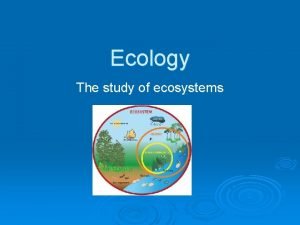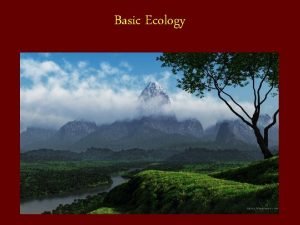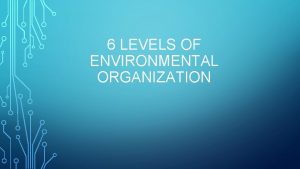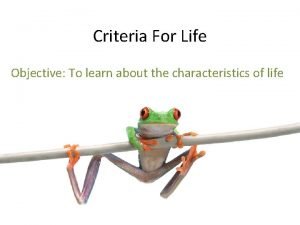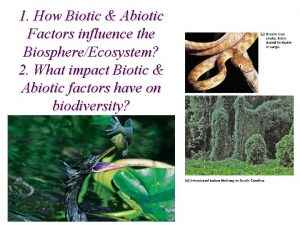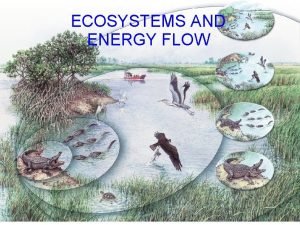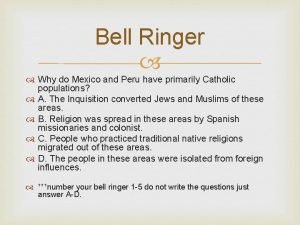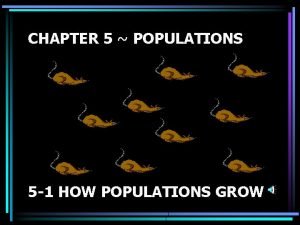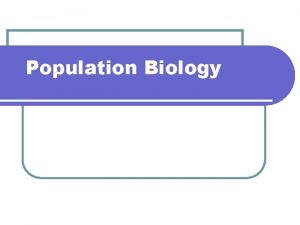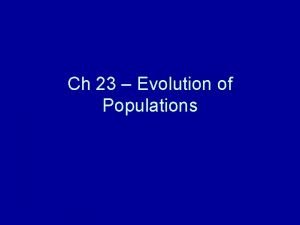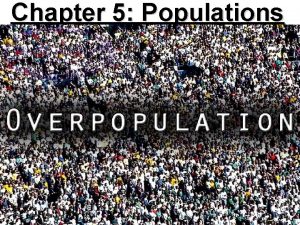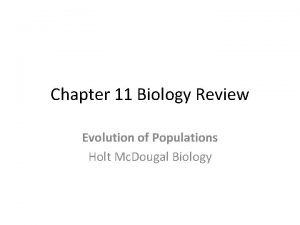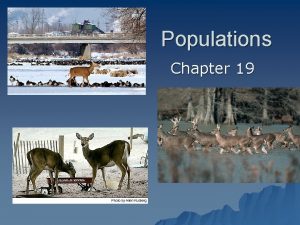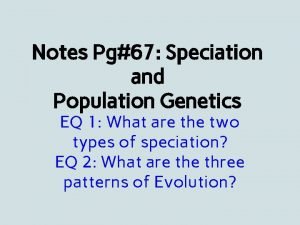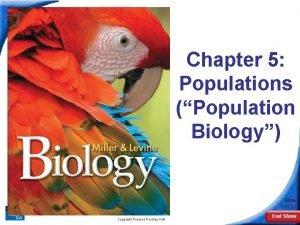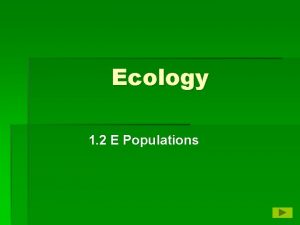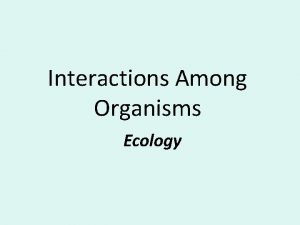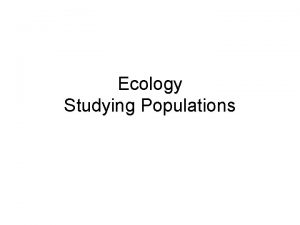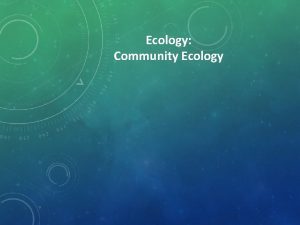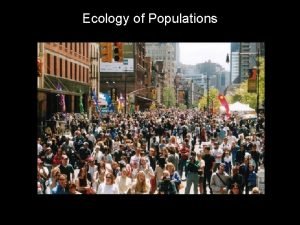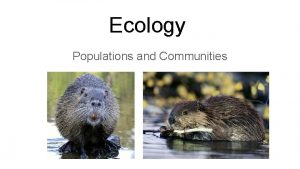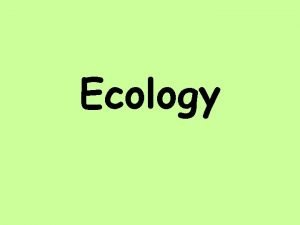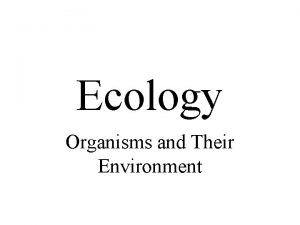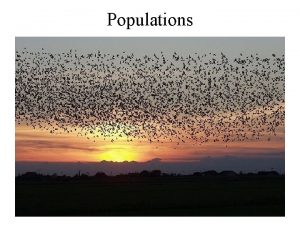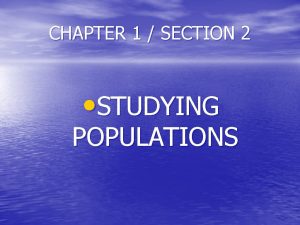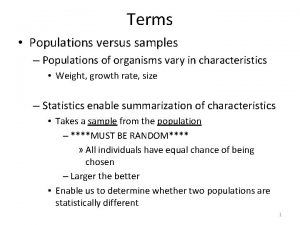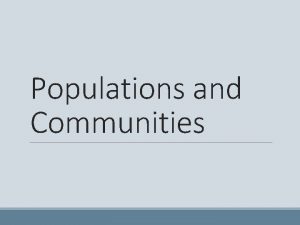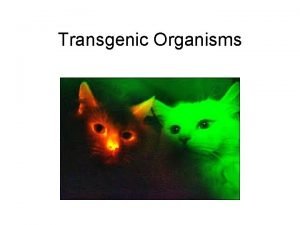Levels Important to Ecology Organisms n Populations n






























- Slides: 30

Levels Important to Ecology Organisms n Populations n Communities n Ecosystems n Biosphere n

COMMUNITY AND POPULATION ECOLOGY

Classification of Communities n n n Physical appearance. forest, grassland, desert, or scrubland. dominant plant species. Species diversity. high diversity (tropical rain forest or coral reef). low diversity (tundra or boreal coniferous forest). Niche structure. how many organisms are in each trophic level. specialists or generalists.

Physical Appearance and Biomes

Community Structure and Diversity

Species present in a community n n n Native species--species present since recorded history began. (oak, hazelnut, ferns) Invasive species--organisms introduced accidentally or intentionally by people. Indicator species--organisms that responds quickly to environmental stress.

European Starling

Starling Range Spread

Zebra Mussel

Purple Loosestrife

Giant Hogweed Attack of the Giant Hogweed

Indicators of Polluted Water n Tadpole snails and Tubifex worms thrive in the low oxygen environments of polluted streams.

Indicators of Clean Water

Keystone Species n n A species that maintains the structure of a community. Sea otters, which prevent sea urchins from destroying kelp “forests. ”

Foundation Species n A species that restores a community if the community is removed.

Competition n n Two or more individuals scrambling or fighting for the same resource. Can be within the same species or between species.

Mutualism

Commensalism

Parasitism

Succession n Succession is a generally predictable change in community composition over time. Primary succession—the progression of species from bare ground to a climax community. (slow) Secondary succession—the restoration of a previously existing community from a disturbance. (rapid)

Michigan Examples n n Succession from open fields to oak-pine forest to maple-beech forest. Succession in lakes filling in to form bogs and then meadows.

Population Terminology n n Population size=(births+immigration)(deaths+emigration). Intrinsic rate of increase called r—related to birthrate. Carrying capacity of the environment—number of individuals the environment can support— called K. K also an important part of biological resistance —all the factors that restrict population growth.

Age Structure n n Many young individuals usually means rapid growth in the future. Many older individuals usually means slower growth in the future.

Exponential Vs. Logistic Growth n n Exponential growth involves ever-increasing rates of growth; produces J-curve. Logistic growth starts out like exponential growth, but slows down as it reaches K; produces S-curve.

r-selected Species

K-selected Species

Comparison of ecological roles of r- vs. K-selected organisms n n Most r-selected organisms are generalists. Exception: parasites. Most K-selected organisms are specialists. Exception: humans.

Next up—Climate and Biodiversity

Pages and Figures to Read n n Compare and contrast r-selected species and K-selected species. - examples of each. Compare and contrast the characteristics of natural systems and humandominated systems. - examples of each.

Human-Dominated vs. Natural Ecosystems n n n Human-dominated ecosystems are: Much “flatter” (fewer trophic levels) Less diverse. Have most of primary productivity directed to human consumption. Regularly disturbed (plowing, construction, etc. )
 Principles of ecology section 3 cycling of matter
Principles of ecology section 3 cycling of matter Principles of ecology organisms and their relationships
Principles of ecology organisms and their relationships Organisms ecology
Organisms ecology Why do organisms interact with other organisms
Why do organisms interact with other organisms Unicellular vs multicellular activity
Unicellular vs multicellular activity 5 levels of organization ecology
5 levels of organization ecology Levels of organization in ecology
Levels of organization in ecology Four levels of ecology
Four levels of ecology Levels of environmental organization
Levels of environmental organization 5 levels of organisms
5 levels of organisms Levels of organisms in order
Levels of organisms in order Living organisms and their surroundings
Living organisms and their surroundings Ammonium
Ammonium Autotroph
Autotroph Level 2 costa questions examples
Level 2 costa questions examples Least important to most important
Least important to most important From most important to least important in writing
From most important to least important in writing From most important to least important in writing
From most important to least important in writing Why do mexico and peru have primarily catholic populations?
Why do mexico and peru have primarily catholic populations? Chapter 5 lesson 1 how populations grow
Chapter 5 lesson 1 how populations grow Population biology definition
Population biology definition Smallest unit of evolution
Smallest unit of evolution Stabilizing selection human birth weight
Stabilizing selection human birth weight Section 5-1 how populations grow
Section 5-1 how populations grow Chapter 21 vulnerability and vulnerable populations
Chapter 21 vulnerability and vulnerable populations Evolution of populations section 11 review
Evolution of populations section 11 review Chapter 13 how populations evolve test
Chapter 13 how populations evolve test Section 19-1 understanding populations answer key
Section 19-1 understanding populations answer key Speciation
Speciation 5.1 how populations grow
5.1 how populations grow Chapter 23 the evolution of populations
Chapter 23 the evolution of populations






